OBSERVING THE PLANETS - Part 4
Last updated: 12 March 2001
OBSERVING THE PLANETS - Part 4 |
The System of Planets Throughout History
From the puzzled wonderment by ancient stargazers until ony a few centuries ago, the skies above us were thought to be fixed against the distant curtain of darkness except for a select few objects that seemed to either move a tiny bit....or in some cases: quite a bit.
Among the rapidly-moving were the "transient phenomena," like brilliant fireballs, or rich meteor showers, the occasional comet, the ghostly apparitions of a glowing curtain of aurorae, or perhaps a nova or "new star." And then - in the category of moving a "tiny bit" - were the SEVEN WANDERERS of the sky....the early Greek philosophers labeled them "planetes," the precursor of our modern title of "planets."
The meteors and comets were commonly associated with "atmospheric disturbances," much like rainbows, sun dogs and lightening. These occasional interlopers were not common, but were laden with superstition and myth even until recent times. Thus, such otherwise unexplainable happenings were blamed on "meteorological" causes.
On the other hand, the seven "wanderers" were well known since earliest mankind first looked skyward, moving slowly amongst the seemingly fixed points of light. They were somewhat predictable to early man, but certainly their motions were not understood. The "seven planetes" consisted of those bodies outside of the earth and its atmosphere: the SUN, MOON, MERCURY, VENUS, MARS, JUPITER and SATURN.
----------------------------
VENUS IN EARLY HISTORY -
The planet Venus is referred to by many even today as both the "evening star" and the "morning star", depending on its ELONGATION (see following) relative to both the sun and the Earth. Even before the makeup and order of the solar system was known, the ancient Chaldean astronomers realized that this bright white planet appeared to "hover" close to the sun at all times and never attain an altitude such that it could be seen throughout the night. Of course, today we understand that Venus is a world not unlike the Earth, a planet orbiting the sun some 67 million miles distant. Only little Mercury is closer.
The striking white brilliance of Venus is unrivaled. The early Chinese astronomers called the body "Tai-pe," or "beautiful white one," and realized that whether seen low in the eastern morning sky at dawn or in the evening western sky at dusk, the appearance was of ONE planet, not two.
Not so for the Egyptian astrological priests who gave Venus in the morning sky the name "Tioumoutiri", and "Ouaiti" when it appeared in the evening; whether they assumed it was TWO separate planets, or merely signified its morning and evening names ritualistically different to "appease" the gods is unknown.
Later in time, Greek and Roman temples, statues and mythology centered around the bright heavenly orb; Polynesian tribes - as did the North American Pawnee - frequently sacrificed maidens to the morning appearance of this bright planet in special circumstances. Hardly fitting, it seems today, for the beautiful orb we commonly know as "the goddess of love."
As to the "planets," we of course no longer associate the Moon and sun among them, and have classified them into two major groups in regard to their relative positives to the Earth. The inferior planets - Mercury and Venus - are located in orbits between the sun and Earth. Their motions in our sky are noticeably different than the other group, the superior planets - Mars, Jupiter and Saturn (and now including the telescopic planets Uranus, Neptune, and Pluto - and perhaps others). The "superior" planets have orbits outside the Earths, or farther from the sun than the Earths orbit.
Because of their locations, the motions of the inferior planets - and hence what we SEE of them in our telescopes - are much different and perhaps a bit more difficult and confusing to keep up with than those outside of our orbit.
Like the moon, all planets have orbits that are elliptical, and all planets follow the pathway through the ecliptic, the 12 Zodiacal constellations which we observe from Earth. But since we watch them from EARTH that also goes around the sun, the planets move at different rates and in different patterns depending on how we see them at any given time.
SUPERIOR PLANETS appear to move slowly eastward month-after- month. Although their motions (particularly the closest to Earth: Mars) CAN be detected in telescopes in a matter of days or weeks as they creep slowly eastwardly relative to the stars, it takes some length of time for naked eye observers to realize the motion.
However, the motions of Venus and Mercury are much different and - at first - seem a little confusing for those not familiar with the makeup of the solar system and our vantage point - Earth - from which we must observe them.
---------------------------
MOTIONS OF VENUS - THE "INFERIOR" PLANETS -
INFERIOR PLANETS move from our vantage point in pathways that are not so neat and understandable as what we see from the more distant superior planets. This is only because of our vantage point and the fact that they are orbiting the sun closer than the Earth. Thus, we must take into account the position of the Earth as well as that of Venus and Mercury when examining their apparent locations in the sky.
Galileo Galilei, in 1610, first exposed the world to the peculiar motions of Venus and Mercury when - in his controversial publication Sidereus Nuncius - he proposed that Venus must travel around the sun, not the Earth as had been held up until that time. After observations through his telescope, with which he discovered the four major satellites of Jupiter, the rotation of the sun from the movements of sunspots, and turned what appeared to be a smooth surface on the moon into an imperfect world of craters, mountains and valleys, he revealed that Venus exhibits phases, just like the moon. From this, he deduced that the only plausible explanation for him - on Earth - to see phases on Venus was that the planet was in orbit around the sun, and closer to it than Earth. (See Figure 1)
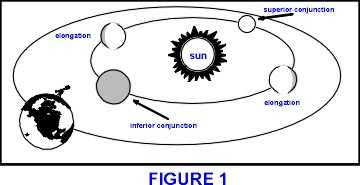
Figure 1 demonstrates the orbit of Venus (or Mercury) around the sun and the relationship to Earth, showing the explanation for the phases (more on this later) of inferior planets. Note that - because an inferior planet is seen ALWAYS in the direction of the sun from Earth - the planet can only be seen either in early evening after sunset, or at or near dawn in the morning. At dark, the Earth is always turned AWAY from the sun, of course, and thus the planet. Figure 2 demonstrates how Venus (and Mercury) will attain a "highest" point (or ELONGATION) as we see it from Earth. In this drawing this would be the "greatest eastward elongation" or the highest east of the sun that Venus reaches as we see it. This would be in the early EVENING SKY above the western horizon. Note that eventually, its path will take the planet "back down" to the horizon and eventually seem to disappear.
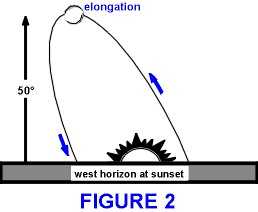
However, in only a very short interval of time - perhaps two weeks - Venus will RE-EMERGE as a morning object seen just prior to sunrise in the Eastern sky; each successive day will result in the planet attaining a higher and higher altitude above the east horizon until it reaches.....you guessed it: "greatest western elongation."
----------------------------
ELONGATIONS OF VENUS AND MERCURY -
Because Mercury and Venus are orbiting the sun closer than is Earth, they can never rise high in the sky (see Figure 2). Rather, they appear to slowly rise out of either the morning or evening sky higher and higher each subsequent morning, momentarily stop that rising path (elongation) then begin to sink ever so slowly back to the horizon.
The process is a slow one, and varies from "year" to "year" for the two planets in relation to the Earths orbit. Elongation in the western sky for both is known as greatest eastern elongation, while that in the early morning eastern sky is greatest western elongation.
The MAXIMUM elevation above the horizon for Mercury is only 28, whereas Venus can attain an elevation of almost 50. At elongation, both appear as "quarter illuminated," much as a quarter moon. The greatest brilliance occurs when Mercury and Venus are nearest inferior conjunction (Figure 1), when both present slim crescents and are very close to the Earth in their orbits.
Mercury (distance from sun average 35 million miles) takes only 88 days to completely circle the sun (its year). Being the closest planet to the sun, it circles inside the orbit of Venus (distance 67 million miles), and thus both exhibit this motion common to the inferior planets.
This motion results in Venus (and Mercury) exhibiting "phases" much like our moon as it encircles the Earth. However, the phases of Mercury are quite difficult to see, even in the largest telescopes. The main reason is that Mercury, being so close to the sun, is always seen in bright twilight sky, very low on the east or west horizon and never attaining the altitude as does Venus. The second reason that phases on Mercury are difficult to discern is that the planet is VERY small, only 3030 miles across (barely larger than our moon!) compared to Venus' diameter of only 200 miles less than that of Earth.
As the inferior planets stretch their limits as high as possible in the eastern and western sky, we are reminded that we are but the third planet of the sun. The motions of the OTHER planets outside of OUR orbit are discussed here only for comparison.
-----------------------------
THE APPARENT MOTIONS OF THE SUPERIOR PLANETS -
Those planets outside the orbit of the Earth exhibit apparent motions much different than Venus and Mercury. Because the more distant any planets orbit is from the sun, the longer time is required for that planet to complete one revolution, or "year." Earth does it in 365 days, and we have seen that speedy Mercury has a "year" of only 88 days.
By comparison, Saturn - at a remarkable distance about about 887,000,000 miles from the sun - completes its trip around the sun once every 29 year years! And Saturn is close compared to Uranus, Neptune and Pluto.
So, based on the table below, it is easy to see how the motion of, say, Mars is quite much more perceptible than that of even Jupiter and particularly of Saturn, the farthest naked eye planet of our solar system.
Since this GUIDE is intended to provide the information and tools necessary for the novice astronomer to get the most out of observing the brilliant planet Venus, the details of celestial mechanics are left out. We don't want to spoil the fun by overloading our cerebral databases.
So - for the most part - we'll leave our discussion of the "superior planets" with the fact that they creep ever-so-slowly EASTWARD each night as we observe them from Earth. Every year however, each planet outside the orbit of Earth will undergo "retrograde motion" in which the star will appear to STOP its motion against the background stars, then slowly REVERSE its course (begin moving westward) for a very short distance only to STOP again and end up resuming its eastward path. This is merely an optical "trick" that the orbit of Earth does to us as it "catches and passes" the planet, much like approaching, then passing and ultimately leaving "in our dust" a slower automobile on the highway. Figure 3 demonstrates a superior planet's pathway as it goes through its "retrograde motion." Venus and Mercury do NOT demonstrate retrograde from the Earth.
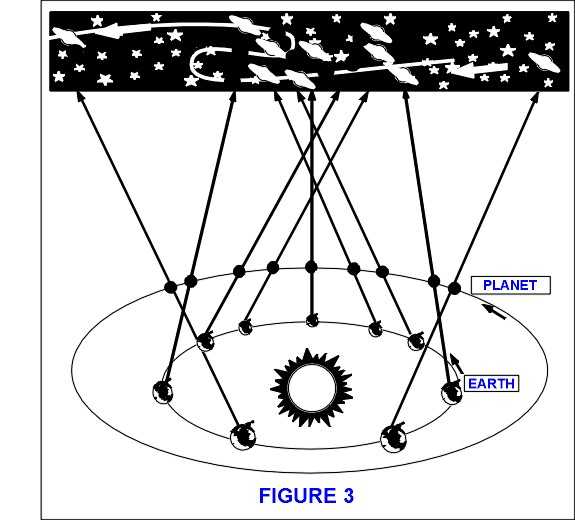
An interesting aside to this, however, is that if you were a Mercurian astronomer, Venus would be a "superior planet" and it, too, would exhibit retrograde motion as would the Earth!
In regard to the superior planets, once their locations have been learned by even the casual stargazer, it is difficult to forget where they will appear in the sky the next season, since their motions are minor when compared to the moon, or even Venus and Mercury. Even if their positions are forgotten or confused from one appearance to another, they can be quickly identified by eachs distinct brightness and color as discussed following.
Let us now examine the physical appearance of the brilliant Venus and many of the attributes - both telescopic and naked eye - that this "goddess of love reveals to our curious eyes and telescopes here on Earth.
----------------------------
BRIGHTNESS AND THE ORBIT OF VENUS -
Venus is a sight to be reckoned with....at magnitude -4.2 it outshines all else in the sky save the sun and moon. It is so bright that it can be seen in full daylight. It is so bright that its brilliance can actually cast a distinct shadow into an otherwise darkened room.
Even when Venus is at "inferior conjunction" (Figure 1) and is showing only a sliver of a crescent to observers on Earth, it can attain its maximum brilliance and size. Venus appears huge by comparison to other planets in a common telescope.
A small 8 x 21 finder can easily spot Venus in the middle of the day. For this reason, GO TO computerized telescopes are particularly useful in observing the planet in daylight, when it can be seen overhead. Actually, observing Venus during daylight somewhat subdues its otherwise overwhelming brilliance. During such observations, it is common to see the irregular patterns of high Venusian clouds at the "terminator" (See Figure 4) and the crescent "cusps" extending far around the peripheral edge of the planet.
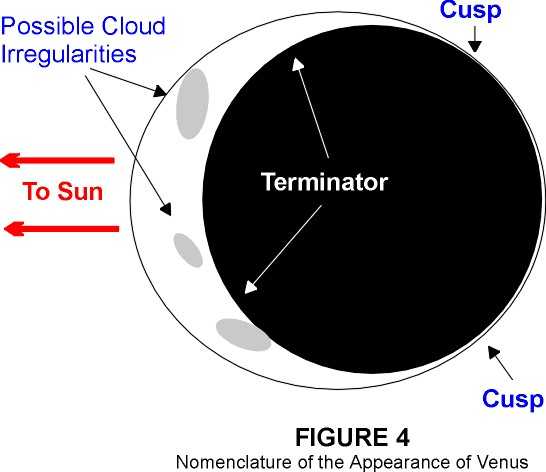
To observe Venus in daylight (the best time by far) with a computerized telescope, follow these simple steps:
1) make sure your telescope is aligned with celestial north (sometimes it helps to leave the scope outdoors and aligned from the previous night if care is taken to cover it for protection);
2) place the telescope in "Home Position;"
3) whether in Alt-Az or Polar mounting mode, do an "easy" star alignment with the telescope; each time a star is selected for you to center, merely hit the "Enter" key and allow the computer to select your next alignment star; do NOT attempt to find the alignment star and center....it is useless;
4) after the alignment is done and the motors are engaged in the telescope, simply scroll to "Object" / "Solar System" / "Venus" and press enter; once located, press "GO TO" and the telescope will take off and get you fairly close to the bright planet;
5) remember I said you can easily see Venus in your 8 x 21 finder? Look carefully (it may take some time for your eye to adjust to the bright blue sky and find the planet, but once you find it, it is unmistakable) and locate Venus and center! You're there!
During daylight hours, you will realize that you can use more magnification to study Venus than you can during night to observe other planets. I commonly use around 410X to observe Venus and many variations of its clouds are easily noted. Note that during daylight hours the air surrounding your telescope is very unsteady, as heat currents will be rising directly from the telescope itself; hence the image is waiver frequently but many moments of excellent "seeing" are awaiting!
Venus is closest for observing (Figure 1) when it is near - but not at - "inferior conjunction" and presents a very thin sliver of a crescent. At such times the disk is very large, attaining a size almost 1/3 LARGER than mighty Jupiter. Frequently, the planet will attain an angular size of over 60 arc seconds when at its brightest.
At each "elongation", Venus is still very bright, but presents a "quarter-moon" shape, or seems half-illuminated as we see it from Earth. Its size will have diminished significantly from inferior conjunction. Figure 5 shows the apparent phases of Venus at its respective positions relative to Earth.
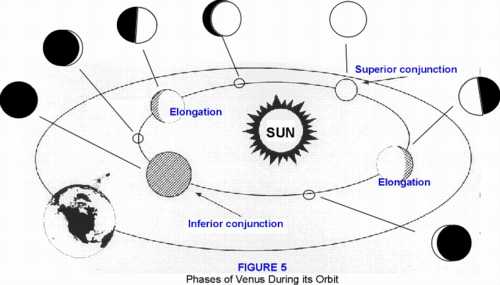
----------------------------------
OBSERVING VENUS -
Venus presents a very difficult world to study. This is a strict rule not only for you and your telescope, but also for the many spacecraft that have ventured close for a look; it is a world cloaked in thick and uninviting clouds of corrosive acids and tornado-force winds.
Venus does not reveal her secrets easily, certainly not to terrestrial based telescopes of any size. But it is a world well worth visiting.....and a world worth a return trip every now and then. Figure 6 shows Venus in "visible light," or in the portion of the spectrum that our eyes observe. In this February 10, 1990 Galileo spacecraft photograph, the planet appears as it might at high magnification when just past ELONGATION toward SUPERIOR CONJUNCTION, presenting a recognizable "gibbous" phase.
In this photograph you can see some of the very subtle detail that MIGHT be visible under extremely steady conditions in your telescope, including the well-defined "terminator" and several wispy "streaks" of darkness within the otherwise very bright cloud tops.
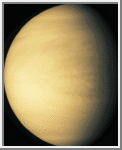
When at greatest elongation, Venus can set a full 3 HOURS after the sun. Beset visibility of the planet is during EVENING hours anytime Venus is visible in springtime in the Northern Hemisphere, and during MORNING hours when the apparition occurs in Autumn.
If you do not observe Venus in the daylight hours, it is best to filter the brightness of the planet for two reasons: 1) a good filter of the right color enhances the penetration of your telescope into the thick "greenhouse" cloud layers of the planet allowing more detail to be seen; and 2) the filter eliminates glare and increases contrast by cutting down so much stray light from the bright planet.
There is not nearly as much detail to be studied on Venus as there might be on Mars, Jupiter, or Saturn. This is because we are not able to see the surface for the thick clouds, as we can with Mars, and unlike Jupiter and Saturn (on which all we can see are also cloud tops) the clouds are virtually featureless and uniformly bright.
Nonetheless, there IS detail to be seen on Venus. Try using a Wratten #47 violet filter to penetrate the clouds of the planet, and also reduce the brightness. You will see a purple-ish discoloration for sure, but the reward in detail is worth it. Among features that you can look for are:
IRREGULARITY IN THE CLOUDS - Particularly along the terminator (Figure 4), there is much variation in the brightness of the Venusian clouds; there are many areas which appear to reflect less sunlight and thereby appear "mottled" to the keen-eyed observer. Frequently, some dark areas might even be glimpsed in the otherwise uniformly bright clouds as well, particularly when Venus is at elongation and demonstrates it "quarter phase."
ROTATION OF VENUS - Although not much can be seen to prove it, in 1890 G.V. Schiaparelli proposed that Venus must rotate on its axis (its "day") the same period in which it revolves around the sun (its "year"), much like the moon orbits the Earth. Indeed, he was correct in this assumption, with the planet rotating - and revolving - at about 224 days. Schiaparelli based his assumptions on direct visual observation of VERY faint cloud detail that moved as the planet turned. Can YOU make out any markings to watch day-after-day? If you observe enough....you can.
EXTENSIONS OF THE CUSPS - Note the elongated "cusps" in Figure 4. As Venus approaches toward inferior conjunction and enters its thin crescent phases from our vantage point, the bright sunlight actually PENETRATES the thick clouds of the planet and SCATTERS throughout many of the cloud layers. This scattering many times allows viewers to see the cusps extended like "embracing arms" around the otherwise dark (unilluminated) side of Venus. Many times it is actually possible (particularly when viewing in daylight) to witness illumination from light scattering of the section of Venus that is NOT directly lighted by sunlight, similar to "earthshine" we see on the moon.
CHANGING OF THE PHASES - Every observer should at least once in his or her "observing career" make a record of the date and phase of Venus through the course of one complete "Venus year" as observed from Earth. All it takes is merely a sketch showing the round ball of the planet, the dark vs. the illuminated portion as you see it, and any irregular/dark blotches that might appear on an otherwise "bright white" surface. Perhaps one of the nicest attributes of this beautiful world is our ability to watch these changes with such little magnification!
----------------------------
Like any lady, particularly one of "goddess stature," Venus does not give up her secrets easily or otherwise.
The story of Venus is one of a paradox in that we have, only 30 million miles away, a sister to planet Earth.....so similar and yet so disproportionately different. On Earth we savor the rich meadows of the wonder of biology and a world in seemingly static balance. And - over there, toward that very bright object in the sky - Venus exhibits the most hostile of all worlds for this glorious creation of life. Both worlds have landforms.....both have abundant water, volcanoes, land quakes and similar gases within their atmospheres, but each is so different than the other.
Venus is a world of the "greenhouse effect" gone wild, perhaps a lesson in nature of what can happen to this precious balance of our own world should we carelessly forget to nurture it.
It is the most mysterious still of all worlds of which we know, hiding the secrets behind a cloak of bright, shimmering disguise. Could it be that this shrouded world is a hint of the future of Earth?
If so....then WHAT must Venus have been like, long ago in ages passed?
-----------------------------
P. Clay Sherrod / Arkansas Sky Observatory, Petit Jean Mountain, Arkansas
Return to the top of this page.
Go back to the Observational Guides & References page.
Go back to my ETX Home Page.